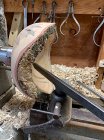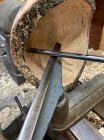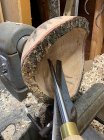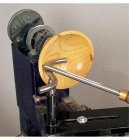Quick background, been turning bowls up to about 11" diameter and maybe 6" deep on my lathe. Been having some challenges with the lower inside corners with vibration and cut quality.
This issue occurs when my gouge is extended furthest off of the tool rest - 3 to 4 inches as I make the turn. I'm using 3/8" gouge (has 1/2" shaft) never sure what size to call it. The tool rest is a standard 12" one for my Delta lathe.
From looking around, there are two things I might do which can help with the issue. First, it seems that when the gouge is not extended, there is not a vibration/quality issue, which leads me to the following: Should I get a larger gouge to help with dampening that vibration, say a 1/2" (5/8" shaft) or look into a "J" style tool rest which will get deeper into the bowls and reduce the overhang need? Each solution ends up around a C note.
This issue occurs when my gouge is extended furthest off of the tool rest - 3 to 4 inches as I make the turn. I'm using 3/8" gouge (has 1/2" shaft) never sure what size to call it. The tool rest is a standard 12" one for my Delta lathe.
From looking around, there are two things I might do which can help with the issue. First, it seems that when the gouge is not extended, there is not a vibration/quality issue, which leads me to the following: Should I get a larger gouge to help with dampening that vibration, say a 1/2" (5/8" shaft) or look into a "J" style tool rest which will get deeper into the bowls and reduce the overhang need? Each solution ends up around a C note.





